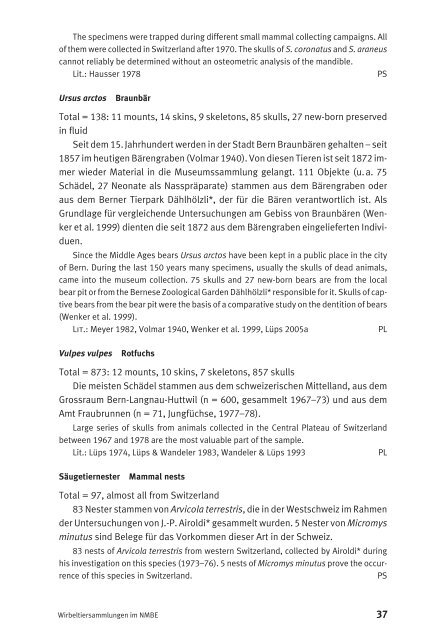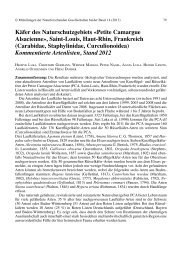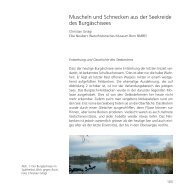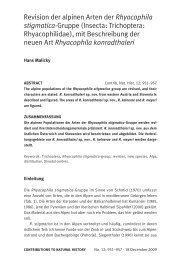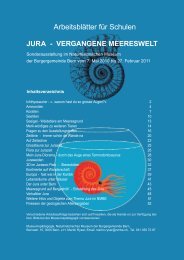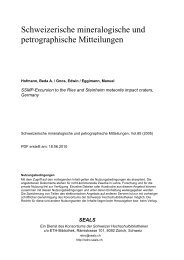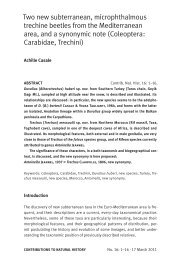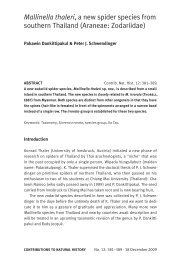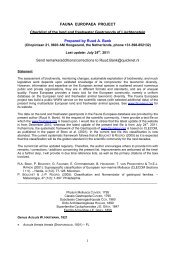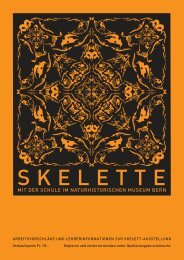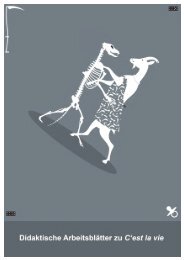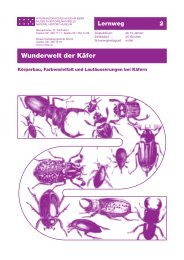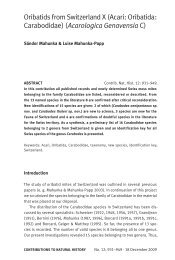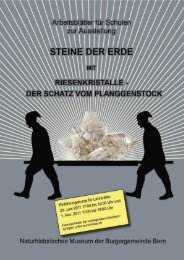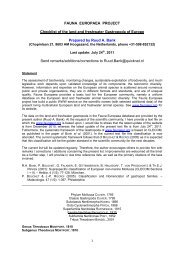Wirbeltiersammlungen im Natur - Naturhistorisches Museum Bern
Wirbeltiersammlungen im Natur - Naturhistorisches Museum Bern
Wirbeltiersammlungen im Natur - Naturhistorisches Museum Bern
Erfolgreiche ePaper selbst erstellen
Machen Sie aus Ihren PDF Publikationen ein blätterbares Flipbook mit unserer einzigartigen Google optimierten e-Paper Software.
The spec<strong>im</strong>ens were trapped during different small mammal collecting campaigns.All<br />
of them were collected in Switzerland after 1970.The skulls of S. coronatus and S. araneus<br />
cannot reliably be determined without an osteometric analysis of the mandible.<br />
Lit.: Hausser 1978 PS<br />
Ursus arctos Braunbär<br />
Total = 138: 11 mounts, 14 skins, 9 skeletons, 85 skulls, 27 new-born preserved<br />
in fluid<br />
Seit dem 15.Jahrhundert werden in der Stadt <strong>Bern</strong> Braunbären gehalten – seit<br />
1857 <strong>im</strong> heutigen Bärengraben (Volmar 1940).Von diesen Tieren ist seit 1872 <strong>im</strong>mer<br />
wieder Material in die <strong>Museum</strong>ssammlung gelangt. 111 Objekte (u.a. 75<br />
Schädel, 27 Neonate als Nasspräparate) stammen aus dem Bärengraben oder<br />
aus dem <strong>Bern</strong>er Tierpark Dählhölzli*, der für die Bären verantwortlich ist.Als<br />
Grundlage für vergleichende Untersuchungen am Gebiss von Braunbären (Wenker<br />
et al. 1999) dienten die seit 1872 aus dem Bärengraben eingelieferten Individuen.<br />
Since the Middle Ages bears Ursus arctos have been kept in a public place in the city<br />
of <strong>Bern</strong>.During the last 150 years many spec<strong>im</strong>ens, usually the skulls of dead an<strong>im</strong>als,<br />
came into the museum collection. 75 skulls and 27 new-born bears are from the local<br />
bear pit or from the <strong>Bern</strong>ese Zoological Garden Dählhölzli* responsible for it.Skulls of captive<br />
bears from the bear pit were the basis of a comparative study on the dentition of bears<br />
(Wenker et al. 1999).<br />
Lit.: Meyer 1982, Volmar 1940, Wenker et al. 1999, Lüps 2005a PL<br />
Vulpes vulpes Rotfuchs<br />
Total = 873: 12 mounts, 10 skins, 7 skeletons, 857 skulls<br />
Die meisten Schädel stammen aus dem schweizerischen Mittelland, aus dem<br />
Grossraum <strong>Bern</strong>-Langnau-Huttwil (n = 600, gesammelt 1967–73) und aus dem<br />
Amt Fraubrunnen (n = 71, Jungfüchse, 1977–78).<br />
Large series of skulls from an<strong>im</strong>als collected in the Central Plateau of Switzerland<br />
between 1967 and 1978 are the most valuable part of the sample.<br />
Lit.: Lüps 1974, Lüps & Wandeler 1983, Wandeler & Lüps 1993 PL<br />
Säugetiernester Mammal nests<br />
Total = 97, almost all from Switzerland<br />
83 Nester stammen von Arvicola terrestris, die in der Westschweiz <strong>im</strong> Rahmen<br />
der Untersuchungen von J.-P. Airoldi* gesammelt wurden. 5 Nester von Micromys<br />
minutus sind Belege für das Vorkommen dieser Art in der Schweiz.<br />
83 nests of Arvicola terrestris from western Switzerland, collected by Airoldi* during<br />
his investigation on this species (1973–76). 5 nests of Micromys minutus prove the occurrence<br />
of this species in Switzerland.PS<br />
<strong>Wirbeltiersammlungen</strong> <strong>im</strong> NMBE<br />
37


